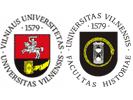Development of Lithuanian ruler’s status and political context has direct influence on the formation of seals’ portrayal as well as on the seal, as insignia itself. Royal insignia expressed the ideology and symbolism of ruler’s power. They played significant symbolic and sacral role during the coronation ceremony.
The oldest royal insignia are crown, sword and lance while the latter lost its significance. Because of the lack of written sources on the coronation and intronization of Lithuanian king and grand dukes seals have enormous advantages over other historical witnesses. The portrayal of figures enriched by additional symbolism give as a clear impression of what insignia were used. The majesty seals of Mindaugas, Gediminas, Vytautas, Švitrigaila, Žygimantas Kęstutaitis not only depicted the rulers’ insignia but also help us to reconstruct the political conception f these rulers. Different insignia were attributed to different ranks of rulers. According to the sphragistics materials Mindaugas being a king used insignia of royal rank (an orb surmounted by a cross and a flowered sceptre). Gediminas being a grand duke also used insignia of royal rank (an orb and a crown) but with slight difference: the crown is in his hand but not on his head. The sword together with mitra (dukes’ cap) is a very important insignia of grand dukes. The portrayal figures of Vytautas, Švitrigaila, Žygimantas Kęstutaitis seals have these insignias. The sword being one of the oldest insignia was already depicted on the Lithuanian rulers’ seals with mounted and unmounted warrior. The sphragistic data also shows that the sword was prerogative of rulers and was not used by those who only belonged to the ruling dynasty.
Examining the Lithuanian seals’ data one could prove that iconographical programme was influenced not only by the medieval sphragistic tradition but also by political aspirations. The seals was not only the sign of authority but also expressed the status of Lithuanian ruler and political realia during the 13th and 15th centuries. The portrayal figure of the seal convey, if still sometimes only symbolically, the ideal of the sovereignty of the person using it.
Įteikta 2004 11 15
Priimta spaudai 2004 12 06 | 

 dizainas ir programavimas giriaus
dizainas ir programavimas giriaus  dizainas ir programavimas giriaus
dizainas ir programavimas giriaus